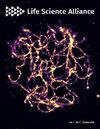Zebrafish tsc1 and cxcl12a increase susceptibility to mycobacterial infection.
IF 3.3
2区 生物学
Q1 BIOLOGY
引用次数: 0
Abstract
Regulation of host miRNA expression is a contested node that controls the host immune response to mycobacterial infection. The host must counter subversive efforts of pathogenic mycobacteria to launch a protective immune response. Here, we examine the role of miR-126 in the zebrafish-Mycobacterium marinum infection model and identify a protective role for infection-induced miR-126 through multiple effector pathways. We identified a putative link between miR-126 and the tsc1a and cxcl12a/ccl2/ccr2 signalling axes resulting in the suppression of non-tnfa expressing macrophage accumulation at early M. marinum granulomas. Mechanistically, we found a detrimental effect of tsc1a expression that renders zebrafish embryos susceptible to higher bacterial burden and increased cell death via mTOR inhibition. We found that macrophage recruitment driven by the cxcl12a/ccl2/ccr2 signalling axis was at the expense of the recruitment of classically activated tnfa-expressing macrophages and increased cell death around granulomas. Together, our results delineate putative pathways by which infection-induced miR-126 may shape an effective immune response to M. marinum infection in zebrafish embryos.斑马鱼tsc1和cxcl12a增加了对霉菌感染的易感性。
宿主 miRNA 表达的调控是一个有争议的节点,它控制着宿主对分枝杆菌感染的免疫反应。宿主必须对抗致病分枝杆菌的颠覆性努力,以启动保护性免疫反应。在这里,我们研究了 miR-126 在斑马鱼-马氏分枝杆菌感染模型中的作用,并通过多种效应途径确定了感染诱导的 miR-126 的保护作用。我们确定了 miR-126 与 tsc1a 和 cxcl12a/ccl2/ccr2 信号轴之间的潜在联系,从而抑制了非 tnfa 表达的巨噬细胞在早期马氏体肉芽肿的聚集。从机理上讲,我们发现tsc1a的表达会产生有害影响,使斑马鱼胚胎易受更高的细菌负荷影响,并通过抑制mTOR增加细胞死亡。我们发现,由 cxcl12a/ccl2/ccr2 信号轴驱动的巨噬细胞募集是以经典活化的 tnfa 表达巨噬细胞的募集和肉芽肿周围细胞死亡的增加为代价的。总之,我们的研究结果描述了感染诱导的 miR-126 可能在斑马鱼胚胎中形成对 M. marinum 感染的有效免疫反应的假定途径。
本文章由计算机程序翻译,如有差异,请以英文原文为准。
求助全文
约1分钟内获得全文
求助全文
来源期刊

Life Science Alliance
Agricultural and Biological Sciences-Plant Science
CiteScore
5.80
自引率
2.30%
发文量
241
审稿时长
10 weeks
期刊介绍:
Life Science Alliance is a global, open-access, editorially independent, and peer-reviewed journal launched by an alliance of EMBO Press, Rockefeller University Press, and Cold Spring Harbor Laboratory Press. Life Science Alliance is committed to rapid, fair, and transparent publication of valuable research from across all areas in the life sciences.
 求助内容:
求助内容: 应助结果提醒方式:
应助结果提醒方式:


